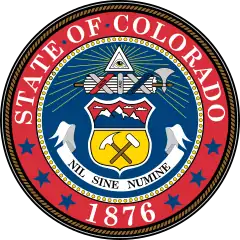Manitou and Pike's Peak Railway
The Broadmoor Pikes Peak Cog Railway (also known as the Pikes Peak Cog Railway) is an Abt rack system cog railway with 4 ft 8 1⁄2 in (1,435 mm) standard gauge track in Colorado, United States, climbing the well-known mountain Pikes Peak. The base station is in Manitou Springs, Colorado, near Colorado Springs.
| Overview | |
|---|---|
| Headquarters | Manitou Springs, Colorado |
| Reporting mark | MPP |
| Locale | El Paso County, Colorado, U.S. |
| Dates of operation | 1889–2017 |
| Technical | |
| Track gauge | 4 ft 8 1⁄2 in (1,435 mm) standard gauge |
| Electrification | none |
| Length | 8.9 mi (14.3 km) |
| The Broadmoor Pike's Peak Railway | |
|---|---|
| Technical | |
| Line length | 8.9 mi (14.3 km) |
| Rack system | Abt rack system |
| Track gauge | 4 ft 8 1⁄2 in (1,435 mm) standard gauge |
| Electrification | none |
| Manitou Springs, Colorado |
|---|
 |
The railway is the highest in North America by a considerable margin. It was built and operated for the tourist trade following its use by people who lived above the town below. As of February 2019, the railway will remain closed until 2021, when it will be reopened with new equipment.[1][2][3]
The Abt rack system will be replaced with the Strub rack system.[4]
History
.jpg.webp)
The railway was started by Zalmon G. Simmons, inventor and founder of the Simmons Beautyrest Mattress Company. The company was founded in 1889 and limited service to the Halfway House Hotel was started in 1890. On June 30, 1891, the first train reached the summit.
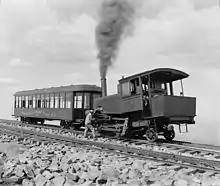
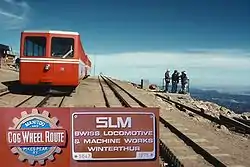
A number of steam locomotives were built for the line by the Baldwin Locomotive Works, all rack-only locomotives with steeply inclined boilers to keep them level on the average 16% grades. Operating steam locomotives on such a line was back-breaking work and expensive, so when more modern forms of traction became available, the railway was eager to modernize.
A gasoline-powered railcar #7 was constructed in 1938. It was designed to be a cheaper alternative to the steam locomotives enabling economic service during quieter times of the year. Proving a huge success, the railway soon bought more internal combustion engined trains. This car is still on property having been re-engined with a more modern Cummins diesel.
The next were five 'streamlined' diesel locomotives from General Electric, which were equipped with matching passenger cars, acquired from 1939 onward.[5] These slowly supplanted the steam locomotives, though some steam operations persisted until the 1960s as backup power and to operate the snow-clearing train (where their greater weight meant they were less likely to derail). A number of the steam locomotives are now on static display, in Manitou and elsewhere, and the Railway still has an operational steam locomotive (#4) and an original coach. The steam locomotive was put out of service for many years before being retrieved from a museum and brought back to service in 1980.
In 1964 the railway needed more equipment, but General Electric was not interested in the business. The railway went abroad, to Switzerland, home of most of the world's cog railways. In 1964, the Swiss Locomotive and Machine Works in Winterthur provided two bright red railcars (railcars contain a seating compartment as well as engineer stand, eliminating the need for a separate pushing locomotive), very similar to equipment used on many Swiss railways. Unit 14 was delivered in 1964 with a pair of air-cooled, 8-cylinder diesel engines that proved to be less than satisfactory on the railroad above treeline. Unit 14 was returned to Switzerland and redesigned to have facilities for water cooling. Unit 14's twin, Unit 15, was also rebuilt to house a pair of water-cooled Cummins 724's. Two more (Units 16 and 17) were built in 1968 to increase the railroads capacity. All four of these units eventually received new Cummins 855 diesels. As of 2017 all four original Swiss trains are still in operation at the Manitou and Pikes Peak Cog Railway.
As tourism increased in the 1970s the railway needed more capacity. In 1976 M&PPRy took delivery of two larger two-car articulated railcars from the Swiss Locomotive and Machine Works of Winterthur, designated Train 18 and Train 19. Passing sidings were built in several places at about the same time, allowing trains to pass at various points on the mountainside. Trains could previously pass only at the Mountain View siding, permitting only three trains a day up the mountain. Eight trains per day became possible with the new equipment and sidings (two additional larger railcars were delivered from SLM; Unit 24 in 1984 and the last, Unit 25, in 1989).
Rolling stock on the M&PPRy consists of four 214-passenger articulated Swiss-built railcars, four 78-passenger Swiss-built railcars, four GE built locomotives (one being rebuilt in 2017 to modern specifications), one snowplow (#22 - built upon the frame of a GE locomotive), one 23-passenger diesel railcar (#7), one steam locomotive (#4 - built by Baldwin), a Winter-Weiss "streamliner" coach, and an original Wasson wooden coach (#104). Only the Swiss-built railcars carry regular passengers. The steam locomotive and passenger coaches are used on rare special occasions, but can no longer make it to the summit due to the demolition of most water towers on the line.
Manitou Incline

More commonly called simply the Manitou Incline, the Mount Manitou Scenic Incline Railway was actually a funicular up the side of a peak called Rocky Mountain located adjacent to Mount Manitou. It was operated by the Manitou and Pike's Peak Railway until its closure following a rockslide in 1990. This line's lower terminus was adjacent to the Cog Railway base station in Manitou Springs. The Manitou Incline averaged almost a 40% grade, gaining 2,011 feet (613 m) in elevation over a length of approximately 1 mile (1.6 km), with the maximum grade being 68%.
The Manitou Incline was initially built in 1907 for use in construction of city water lines and a hydroelectric plant. When the construction was finished, the Manitou and Pike's Peak Railway took over the cable car as a tourist operation.
From 1990 forward, the defunct Incline had been controversial because, although legally off-limits to the public, its roadbed was heavily used for recreation and exercise by people ignoring the trespassing signs. It became legal to use the Incline on February 1, 2013.[6] Colorado Springs Parks and Recreation manages the Incline trail through an intergovernmental agreement.[7]
Recent Operations and Present Status

As of 2017 the railway owns enough equipment (railcars and snow plows) to run six to eight trains per day from mid-May through mid-September. During "off-peak" months (mid-September through mid-December and mid-March through mid-May), from one to five trains are run per day, with additional trains added if there is sufficient demand.
The railway was usually closed from mid-December through mid-March unless the snow plows were able to clear the line, but in 2006 the railway began year-round service. The winter service varies according to demand: in January, for example, trains run once a day on weekends and holidays. These Winter operations were suspended on October 29, 2017, for maintenance to the railway. In March 2018 it was announced that the railway would remain closed indefinitely while feasibility studies are completed.
On June 13, 2018, the Manitou Springs City Council approved a pair of tax incentives to fund repairs of the railway.[8] On November 29, 2018, it was announced that the tax incentives had been approved, and that reconstruction would begin in Spring 2019 for a projected 2021 reopening; the project will see all track replaced, the Manitou Springs depot remodeled, and Cars 14, 16, and 17 retired (Car 15 will be retained for maintenance-of-way duties) in favor of three trainsets manufactured by Stadler Rail; the Stadler order consists of three locomotives and nine passenger cars, marking a return to locomotive-hauled trains; Cars 18-19 and 24-25 will be refurbished and remain in service.[9][10][11]
On November 19, 2020, it was reported that the new Stadler rolling stock is ready for commissioning.[4]
Locomotive roster
| No | Built | Manufacturer | Type | Builders number | Class | Status | Notes | Photo |
|---|---|---|---|---|---|---|---|---|
| 1 | 4/1890 | Baldwin Locomotive Works | Steam Locomotive | 10835/13318 | 0-4-2T | On display at the Colorado Railroad Museum | Originally built as the "John Hulbert", rebuilt as a Vauclain Compound and numbered #1 in 3/1893 | |
| 2 | 5/1890 | Baldwin Locomotive Works | Steam Locomotive | 10919/13319 | 0-4-2T | On Display in Manitou Springs | Originally built as the "Manitou", renamed to "T.F. Richardson" at some point before 1898. Rebuilt as a Vauclain Compound and numbered #2 in 3/1893. | |
| 3 | 5/1890 | Baldwin Locomotive Works | Steam Locomotive | 10920/13324 | 0-4-2T | Scrapped for parts | Originally built as "Pike's Peak", rebuilt as a Vauclain Compound and numbered #3 in 3/1893 | 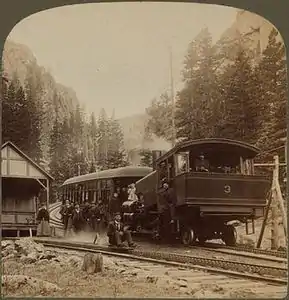 |
| 1st 4 | 5/1892 | Baldwin Locomotive Works | Steam Locomotive | 12681 | 0-4-2T | Wrecked 8/31/1896, scrapped | The smallest engine the railway owned, was known as the "little 4". It was the first engine delivered as a Vauclain Compound, and its superiority over the previous 3 engines resulted in them being sent back to Baldwin to be rebuilt. Broke a side rod and ran away in August 1896. | |
| 2nd 4 | 1/1897 | Baldwin Locomotive Works | Steam Locomotive | 15173 | 0-4-2T | Operational, run on special occasions with coach 104 | Built to replaced wrecked #4. Built to the specifications of the original larger engines. #4 Was sent to the Colorado Railroad Museum after retirement in October 1968. It was then traded for #1 in November 1979. | |
| 5 | 4/1901 | Baldwin Locomotive Works | Steam Locomotive | 18939 | 0-4-2T | On display in front of Broadmoor Hall | First engine built with an automatic brake. This engine was displayed at the Cog Railway Depot in Manitou for many years before being moved to the Broadmoor Hotel and put on display. | 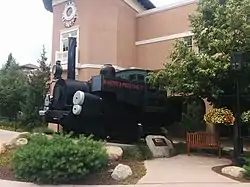 Number 5 in flower bed at Broadmoor |
| 6 | 6/1906 | Baldwin Locomotive Works | Steam Locomotive | 28401 | 0-6-0T | Scrapped 1955 | #6 was delivered as an Oil burner, it was converted to burn coal in 1907. #6 was the largest and most powerful engine delivered to the cog railway, however it suffered from mechanical issues and was usually the last engine in the lineups. | |
| 7 | 1938 | Colorado Midland Shops | Gas Railcar (Diesel) | On Display at the Colorado State Railroad Museum | #7 was built in the Colorado Midland shops in 1938 for the purpose of having a smaller piece of equipment to run that was cheaper to operate when the off season occurred. Originally GM powered with 707 gasoline engines, it was repowered by Cadillac V8 in the early 1950s and finally with a Cummins diesel in the 1990s. | |||
| 8 | 1939 | General Electric | Diesel Electric Power car | 12454 | Retired, sold to the Garden of God, Colorado Springs | First GE Unit delivered to the railway, builders number 12454. It had 3 2 stroke General Motors 71 engines and internal Dynamic brakes. Was retired with the arrival of the Swiss units and robbed of parts to maintain other engines. | 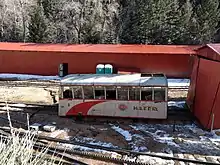 | |
| 9 | 1946 | General Electric | Diesel Electric Power car | 28372 | On Display at the Colorado State Railroad Museum | Unit 9 was powered by 2 Cummins NHS diesels as built. Later rebuilt to have twin Cummins 855 Diesels. | ||
| 10 | 1950 | General Electric | Diesel Electric Power car | 30279 | Frame re-used for snowplow #22 | Unit 10 was powered by 2 Cummins NHS diesels as built. The frame of this unit was the basis for snowplow 22. | ||
| 11 | 1950 | General Electric | Diesel Electric Power car | 30280 | Retired, sold to the Garden of God, Colorado Springs | Unit 11 was powered by 2 Cummins NHS diesels as built. Later rebuilt with Cummins 855 diesels. |  | |
| 12 | 1955 | Manitou and Pikes Peak shops | Diesel Electric Power car | On Display at the Colorado State Railroad Museum | Built by the railroad shops, unit 12 was powered by 2 General Motors 110 diesels. Was built to the same body style as the GE built units. Rebuilt to Unit 23 1982. | |||
| 14 | 1963 | Swiss Locomotive and Machine Works | Diesel-Electric | 4441 | Bhm 2/4 | Retired, sold to GE Johnson construction | 78 Passenger. 14 was built with air-cooled V8 diesels. Rebuilt in the shops to have Cummins 743 engines following the air-cooled engine's failures at altitude. Later re-engined with Cummins 855's from units 18/19. | |
| 15 | 1963 | Swiss Locomotive and Machine Works | Diesel Electric | 4442 | Bhm 2/4 | Active Service | 78 Passenger. Built with air-cooled V8's. It was returned to Switzerland after overheating issues and received Cummins 743's. Later 855's from units 18/19. | |
| 16 | 1968 | Swiss Locomotive and Machine Works | Diesel Electric | 4778 | Bhm 2/4 | Retired, sold to GE Johnson construction | 78 Passenger. Built with Cummins 743's, re-powered with a big cam 855. | |
| 17 | 1968 | Swiss Locomotive and Machine Works | Diesel Electric | 4779 | Bhm 2/4 | Retired, sold to GE Johnson construction | 78 Passenger. Built with Cummins 743's, re-powered with 855's from units 18/19. | |
| 18 | 1975 | Swiss Locomotive and Machine Works | Diesel Hydraulic | 5046 | Bhm 4/8 | Active Service | 214 Passenger. Built with Cummins small cam 855's, later re-powered with big cam 855's. | 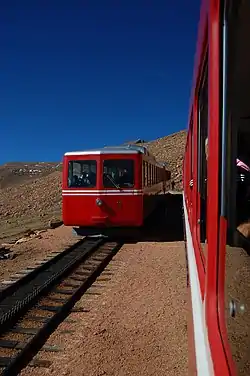 |
| 19 | 1975 | Swiss Locomotive and Machine Works | Diesel Hydraulic | 5047 | Bhm 4/8 | Active Service | 214 Passenger. Built with Cummins small cam 855's, later re-powered with big cam 855's. | |
| 20 | 1934 | Manitou and Pikes Peak Shops | Gas Work Car | Scrapped | A self-propelled work truck built in the shops in 1934. Its original Pierce Arrow engine was replaced by #7's former 707 engine in the 1950s. Unit later received the number 20 and was scrapped in 1982. It was replaced in work service by a rebuilt unit 23. | |||
| 21 | 1953 | Manitou and Pikes Peak Shops | Rotary Snowplow | Scrapped | Built in house in the 1950s, powered by General Motors 110 engines. This rotary snowplow proved to be unsuccessful in clearing large drifts from the track and it was replaced with snowplow 22. | |||
| 22 | 1974 | American Snowblast | Snowplow, Diesel Hydraulic | Active Service | Built on the frame on GE #10. Fully Diesel Hydraulic with a Cummins 1710 V-12. | |||
| 23 | 1982 | Manitou and Pikes Peak shops | Diesel Electric Power Car | Retired | Shop built unit #12 was rebuilt to unit 23 following the scrapping of work car 20. It had a roll up door and single Cummins 855 for power. | 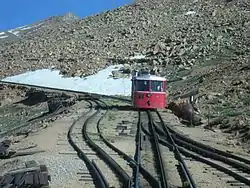 | ||
| 24 | 1983 | Swiss Locomotive and Machine Works | Diesel Hydraulic | 5275 | Bhm 4/8 | Active Service | 214 Passenger. Delivered with Cummins 855's. | 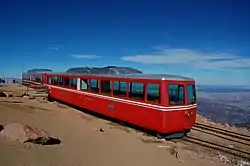 |
| 25 | 1988 | Swiss Locomotive and Machine Works | Diesel Hydraulic | 5418 | Bhm 4/8 | Active Service | 214 Passenger. Delivered with Cummins 855's. | |
| 104 | 1890 | Wasson Wooden Coach | Passenger Coach | Active Service | 214 Passenger. | |||
-All steam locomotives were rebuilt in 1912 with new frames and rod arrangements in the Manitou shops using kits supplied by Baldwin Locomotive works. This resulted in all engines having boilers of 44 inches in diameter, 19.7 Square feet of grate area, a total heating surface of 576 square feet, and a water capacity of 600 gallons. These engines would burn slightly under 1 ton of coal per trip.[13]
-The Diesel Hydraulic units 18/19/24/25 were built with transmissions built by twin disk in Wisconsin. These had Voith hydraulic retarders installed to the transmissions. In 1997, units 18 and 19 received new Voith T211 turbo transmissions with built in retarders. In 2003, units 24 and 25 also received the Voith transmissions.
Gallery of old engines
 Preserved Baldwin Engine No. 1 on public display at the Colorado Railroad Museum, December 2007.
Preserved Baldwin Engine No. 1 on public display at the Colorado Railroad Museum, December 2007. Preserved Baldwin Engine No. 2 on public display in Manitou Springs, October 2012.
Preserved Baldwin Engine No. 2 on public display in Manitou Springs, October 2012.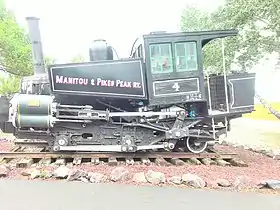 Baldwin Engine No. 4 on public display in Williams, Arizona, August 2020
Baldwin Engine No. 4 on public display in Williams, Arizona, August 2020 Preserved Baldwin Engine No. 5 on public display at Manitou Springs Depot, Sept 2006.
Preserved Baldwin Engine No. 5 on public display at Manitou Springs Depot, Sept 2006. Fourteen thousand feet above the sea, Pike's Peak, Colorado, U.S.A, from Robert N. Dennis collection of stereoscopic views
Fourteen thousand feet above the sea, Pike's Peak, Colorado, U.S.A, from Robert N. Dennis collection of stereoscopic views
Gallery of the line
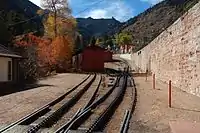 Manitou Springs - Train Station
Manitou Springs - Train Station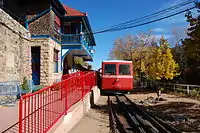 Getting ready for departure
Getting ready for departure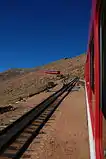 Another train approaching at Windy Point
Another train approaching at Windy Point Two trains at Windy Point
Two trains at Windy Point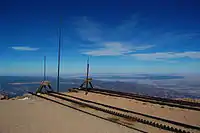 End of track at the summit
End of track at the summit Salida 24
Salida 24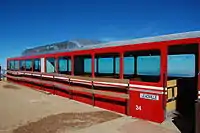 Leadville 24
Leadville 24 Train #24 at the summit
Train #24 at the summit
See also
References
- "Home". Pikes Peak Cog Railway. Retrieved March 15, 2018.
- Morrison, Holly (March 13, 2018). "Pikes Peak Cog Railway to remain closed for remainder of 2018". News 13. Archived from the original on June 12, 2019. Retrieved March 18, 2018.
- Falcone, Bob (March 16, 2018). "Cog Railway closure could impact recreation on Pikes Peak". Colorado Springs Independent. Retrieved March 18, 2018.
- "Pikes Peak rack railway coach ready for commissioning". RailwayGazette. 2020-11-19.
- "Famous Cog Railway Goes Streamline" Popular Science, November 1939
- Manitou Incline Opens Friday Archived 2013-02-03 at the Wayback Machine, KRDO.com, Jan 31, 2013
- Manitou Incline Site Development and Management Plan, manitouspringsgov.com, Feb 4, 2011
- "Plan To Rebuild Cog Railway Chugs Ahead". CBS Denver. CBS Denver. Retrieved 14 June 2018.
- Staff, Web. "Pikes Peak Cog Railway to reopen in 2021 after owner agrees to $100 million reconstruction". FOX31 Denver. FOX 31 Denver.
- wayneh@gazette.com, Wayne Heilman. "Pikes Peak Cog Railway orders engines, cars, rail for $100 million rebuilding project". Colorado Springs Gazette. Retrieved 2020-08-20.
- "Altamont Press Discussion Board :: Discussion :: Re: Meanwhile at Pike's Peak". www.altamontpress.com. Retrieved 2020-08-22.
- Abbott, Morris W. (1972). The Pike's Peak Cog Road. Pulpit Rock Press. p. 99. ISBN 0-9624008-2-3.
- Abbott, Morris W. (1972). The Pike's Peak Cog Road. Pulpit Rock Press. p. 163. ISBN 0-9624008-2-3.
External links
| Wikimedia Commons has media related to Manitou and Pike's Peak Railway. |
